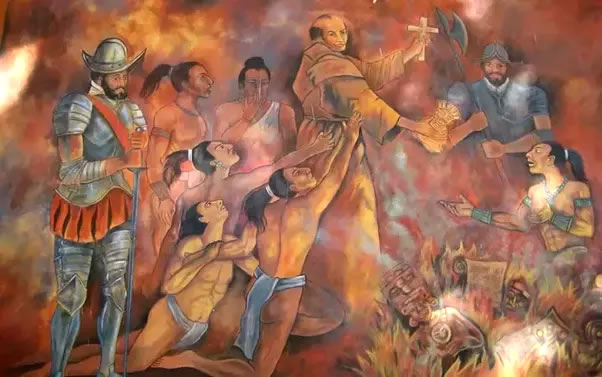Among the first Spaniards to venture into the Maya heartland of the Yucatán Peninsula, the Franciscan friar Diego de Landa owes his fame, and infamy, to two distinct but related actions.
His infamy rests on his systematic destruction of dozens of Maya texts (or codices) and thousands of Mayan idols in his crusade to extinguish idolatry and spread Christianity among the Maya in the 1560s—a crusade accompanied by tortures, burnings at the stake, and many other atrocities against the region’s indigenous inhabitants.
Yet Landa was also among the earliest experts on Mayan language and culture, his Relación de las cosas de Yucatán (Account of the Things of Yucatán, 1556) representing a landmark document that provided an exceptionally vivid, detailed, and important description of Maya language and culture, and that proved key in the eventual decipherment of ancient Maya texts in the second half of the 20th century.
  |
Landa thus occupies a peculiar and highly ambiguous position as both the most important early destroyer and preserver of knowledge on the preconquest Maya of Yucatán.
Born in Cifuentes, Guadalajara, Spain, on March 17, 1524, Landa entered the Franciscan monastery of San Juan de los Reyes in Toledo in 1540. Nine years later he journeyed to Yucatán as part of the broader missionary effort to convert the New World’s indigenous inhabitants to Christianity.
His first several years were spent at the monastery at Izamal, learning Mayan, revising an existing grammar, and undertaking the routine duties of Franciscan missionaries: preaching, tending to the sick, performing sacraments.
 |
| Diego de Landa burnt codeces |
Growing restless, Landa sought and received permission to venture alone into the interior, where he spent many months wandering through large parts of the peninsula and acquiring intimate knowledge of Mayan language and culture.
In 1553, he returned to the monastery at Izamal and supervised the construction of a permanent structure at the prominent Maya religious center. Eight years later, in 1561, the General Chapter of the Franciscans appointed the 37-year-old Landa as the region’s first provincial.
By 1562, Landa had overseen the construction of 12 monasteries and the baptism of thousands of Maya, who Landa believed had abandoned their idols and embraced the Christian faith.
   |
In May 1562, a chance discovery of a cave near the village of Maní containing numerous idols and human skulls launched Landa on a crusade to extirpate, once and for all, idolatry among the natives.
Employing a torture technique known as the garrucha, or hoist (in which the individual was bound at the wrists, hoisted into the air, and lashed, sometimes with large stones attached to the feet and hot wax hurled onto the body), the friars gained numerous “confessions” from the natives on their continuing adherence to non-Christian religious beliefs and practices.
Soon afterward, on Sunday, July 12, 1562, the friars celebrated a massive auto-da-fé at Maní, in which great piles of idols (including at least 27 Maya manuscripts, or codices) were set to the torch, and various punishments meted out to offenders against the Christian faith, including floggings, incarceration, and fines.
The inquisition continued for the next three months. Altogether an estimated 4,500 natives were tortured, with many hundreds left permanently disabled and 158 dying in consequence of the interrogations.
Landa’s illegal and unauthorized excesses led to a prolonged power struggle with the region’s bishop, Francisco de Toral, whose authority he was charged with usurping. Ordered back to Spain, he was absolved by the Council of the Indies, and in 1573 he returned to Yucatán as second bishop of Mérida, in which capacity he served until his death on April 30, 1579.
